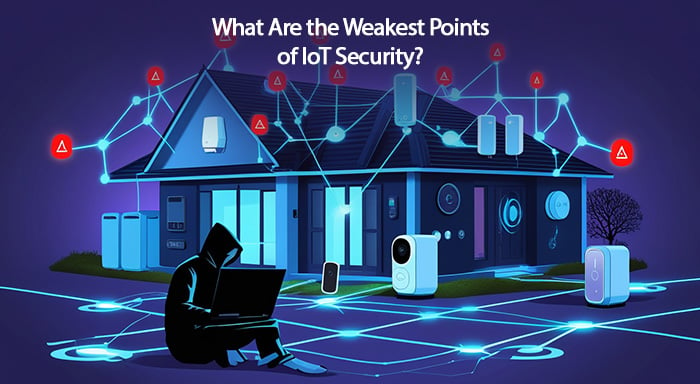We are surrounded by IoT devices, whether at home or in the workplace – ranging from refrigerators and air conditioners to doorbells. While these devices make our lives easier, they also create new security risks. Since Internet of things (IoT) devices work by connecting to physical objects through Wi-Fi or Bluetooth, allowing them to collect and act on data. This makes them more vulnerable to security threats.
Let’s explore what are the weakest points in IoT security, which is one of the challenges of IoT, and learn how to prevent potential threats.
Weak Authentication
Weak authentication is one of the main weaknesses in cybersecurity. It makes connected devices highly vulnerable to unauthorized access, which increases the risk of cyberattacks. Sometimes IoT devices come with default usernames and passwords that users often forget to change. Since these usernames are widely known, it increases the chance of security risk, as attackers can easily get unauthorized access. Additionally, simple passwords, lack of two factor authentication and weak encryption protocols can hinder authentication.
Data Privacy Risk
Data privacy is a significant threat to IoT devices because these devices collect and transmit very delicate data. If your data is not secured, it can be seized, snatched or misused by hackers. There are many IoT devices that transmit their data without encryption, which makes it more accessible to attackers. Certain technologies gather more information than is required, which raises the possibility of exposure if security measures are weak.
Botnet attacks
Botnet attacks are increasing and becoming very common nowadays. These attacks use the network of your device and bots to execute malicious activities. Botnet attacks often target devices with weak authentication and outdated firmware. Once attackers successfully infect a device, they can use it to launch Distributed Denial-of-Service (DDoS) attacks. These attacks can hamper your services and networks and can be used for illegal access to sensitive systems.
Ransomware Attacks
Ransomware attacks are a growing threat in the IoT industry, posing serious risks to both companies and individuals. Through these attacks, cybercriminals can gain access to devices, encrypt personal data, and demand payment to unlock them. Once ransomware enters a system, it does not stop at a single device. It spreads swiftly, affecting entire networks and causing widespread damage.
What Is IoT | History, Benefits of IoT?
Lack of Updates
A lot of IoT manufacturers provide limited or no security updates, which can lead to cyber threats. Organizations that often fail to notify users about critical updates may face compliance violations and legal penalties. By making the update process overly complicated, they create security gaps that cybercriminals can exploit to gain unauthorized access and steal sensitive data.
Supply Chain Problem
Businesses rely on outside vendors, from software developers to hardware suppliers. These types of supply chains are often targeted by attackers seeking access to IoT environments by compromising updates or inserting backdoors into reliable assets. Such security breaches allow cybercriminals to gain access to vital systems without authorization. Therefore, ensuring strong supply chains is crucial to preventing such attacks.
Weak Physical Security Measures
When we talk about IoT security, we often focus on network protection while overlooking the physical security of devices, making them easier targets for attackers. If an attacker gains physical access to your device, they can exploit both the device and its data. This makes physical security a crucial part of digital defense.
Real-world Consequences
- Breach of Confidentiality: Digital cameras, smart speakers, or baby monitors can be hacked to spy on your family.
- Home invasion: Criminals can hack the smart locks of your home or shop to gain unauthorized physical access.
- Financial loss: Smart payment systems or data from smart devices might lead to unauthorized use of personal information.
- Online security breaches: Your insecure devices can be used in botnets to attack websites and services.
Steps To Prevent Security Threats
- Change default passwords-
You should set a strong and unique password for organizations or personal use
- Update regularly--
Whenever new firmware or software is available you should update your device
- Create a separate network--You should isolate your IoT devices from your main network
- Disable features- Do not use features you do not require. For example, disable remote control unless it is necessary and proper security measures are in place.
- Choose your device wisely - Choose manufacturers that provide regular security updates and prioritize cybersecurity
- Turn off devices- When you are not using your device, turn it off your device as it can't be hacked when unplugged.
Future of IOT security
The future of IoT security is emerging rapidly as cyber threats become more sophisticated and the number of IoT devices continues to grow. Here are some key trends shaping the future of IoT security.
- Unified protocols
Organizations are implementing device management protocols like TR- 069 and OMA-DM to automate the processes of threat detection and minimize risks.
- AI-driven security
The integration of Artificial Intelligence in IoT security frameworks enables real-time detection and prevention of cyberattacks.
- Integrating blockchain technology
The future of IoT models will be based on blockchain technology, which ensures secure data exchanges in IoT networks and create decentralized trust models.
- Regulatory compliance
Private industries and government bodies are enforcing strict IoT regulations to make sure manufacturers put strong security safeguards in place.
Conclusion
So, in this blog we have explored what are the weakest points of IoT security, knowing these security threats can keep your smart home both convenient and secure. In this digital world it is easy to get into the comfort of home automation and smart devices, but we never pay attention to its potential drawbacks. By understanding potential security risks in our IoT devices, we can not only protect our technology but also safeguard our personal space and identity.
The future of IoT security is not just about building perfect security for devices, it is about creating smart devices that can detect and fight with random threats. As technology is evolving, we must be aware of the security of our devices. Our smart devices can detect threats, but we can protect them better.
Knowing about weakest security points in IoT is also crucial for IoT developers as it can be asked in IoT interview.
You should always remember the smartest part of a smart home should be you - the informed user who understands the basics of keeping connected devices secure.



